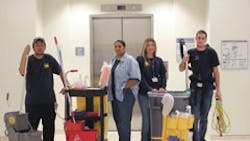GCA 2011 Higher Education Honorable Mention: University of Michigan
University of Michigan (Ann Arbor, Michigan)
Program Information
Number of students: 41,924
Square footage maintained: 14 million
Number of full-time custodians: 400
Annual cleaning budget: $22 million
Green cleaning team members: John Lawter, Assoc. Director, Plant Building & Grounds Services; Darryl Betts, Colette Donner, Carie Kloack, Henry Musial, Area Mgrs.; Kristin Brancheau, Business Mgr.; Bill McAllister, Garage Sr. Supervisor; Jan Allen, Trainer
The University of Michigan’s Plant Building & Grounds Services (PBGS) department began green cleaning in May 2009 with the introduction of the OS1 (Operating System One) cleaning program to campus.
The impetus for this change from our traditional zone-cleaning system was to increase building cleanliness in light of declining budgets, we have embraced the (OS1) philosophy of “clean first for health, then for appearance.”
Thus far, our program has resulted in the reduction in chemical use and storage on campus from more than 50 products to less than 10. Additionally, 257 full-time employees and 12 temporary employees have been retrained in the (OS1) system of cleaning for health, disposing of wastes in an environmentally-friendly manner, employing ergonomic practices, improving building sanitation, removing pollutants and reducing chemical, particle and moisture residue.
We are in our second year of a 3-year rollout of the program to campus. Our green cleaning system is now in 101 of our 236 campus general fund buildings, equating to 70 percent of building area, with a completion date for rollout in May 2013. Additionally, PBGS is currently piloting the use of ozonated-water for cleaning, following the successful deployment of the strategy within the university’s housing department, which cleans its own facilities. This ozonated-water serves as a non-toxic oxidizer, cleaner and sanitizer. The pilot in the University of Michigan School of Natural Resources and Environment is slated to begin in Fall 2011.
From the onset of the decision to deploy (OS1) to the University of Michigan campus through today, stakeholder engagement has been at the top of the priority list. This is not only to ensure support for the change in how buildings are cleaned but to educate campus users on the environmental and human health impacts of this new system. To date, PowerPoint presentations have been made to the following groups:
-Executive Leadership Group, comprised of the University’s president and vice presidents
-Executive Planning Group, comprised of deans and directors from individual colleges, schools and institutes
-Budget Administrators Group, comprised of the business managers for the colleges and schools
-Custodial Services Process Improvement Team, comprised of staff members concerned about campus custodial issues
-Facility Users Network, comprised of facility managers from colleges, schools, institutes and departments on campus
Additionally, presentations have been made to audiences from outside the University of Michigan, enabling us to reach a broader audience and spread the word about the importance of cleaning for human and environmental health. Members of our department have presented on (OS1) at the Big 10 & Friends and MiAPPA (Michigan Association of Physical Plant Administrators) conferences. Attendees included those from peer institutions who are responsible for custodial services as well as their colleagues who may be able to encourage them to further investigate green cleaning.
Since beginning the (OS1) program, U-M Plant Building and Grounds Services has achieved CIMS (Cleaning Industry Management Standard) certification. Additionally, in 2009, our program received the Rookie of the Year award from (OS1) and, in 2010, the Peer Influencer award for encouraging other schools to adopt the program.
